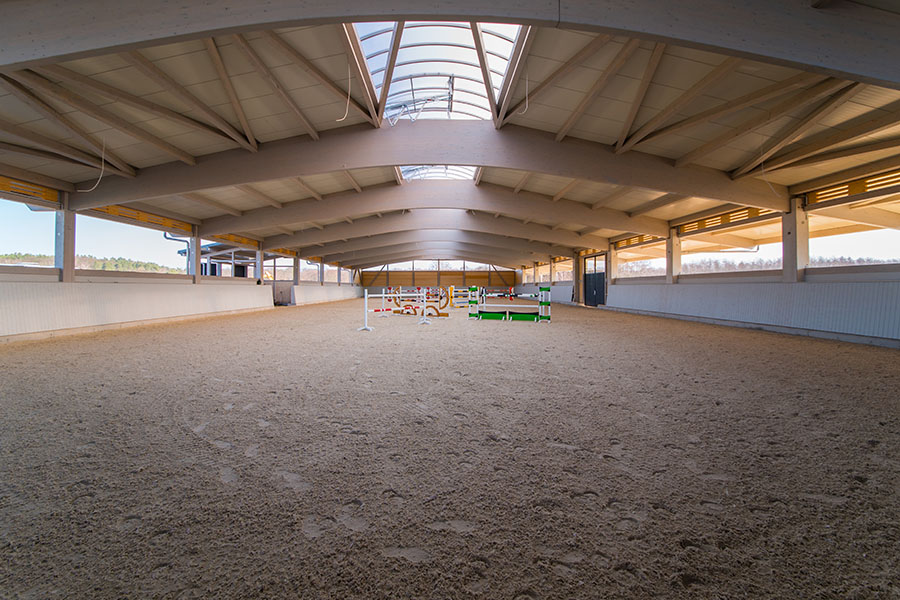Building a horse riding arena is a significant investment that requires careful planning and execution. It’s more than just laying down a stretch of dirt; it involves multiple technical aspects that can make a dramatic difference in performance and longevity. Whether you’re aiming for a grand showpiece or a functional everyday training ground, understanding the foundation is key to achieving a top-quality arena.
“The base is the foundation upon which everything else rests. If miscalculated, it can lead to performance issues and costly repairs in the future.”
Where to Begin
Embarking on a horse arena construction project requires detailed planning from start to finish. By mapping out your project ahead of time, you can avoid unnecessary delays and complications.
Common obstacles like insufficient materials or unexpected costs can cause a project to stall. Additionally, uncertainty about the next steps can also slow down progress. Before you begin building or renovating your outdoor horse arena, consider and finalize the following essential aspects in our cohesive step-by-step horse arena construction guide.
Simple Step-by-Step Guide
Building a high-quality horse arena involves several crucial steps and considerations. In this article, we will delve deeply into various aspects that contribute to the overall performance and durability of an arena. Here’s an overview of the key facts that we will cover:
- The importance of precise arena dimensions for different disciplines.
- A breakdown of the cost factors involved in constructing an arena.
- Effective drainage solutions to ensure longevity and performance.
- Essential tools and equipment needed for successful arena construction.
Understanding these critical elements will empower you to make informed decisions about your horse arena design and maintenance, ensuring a safe and high-performance space for equestrian activities.
#1: Assessing Your Arena Dimensions
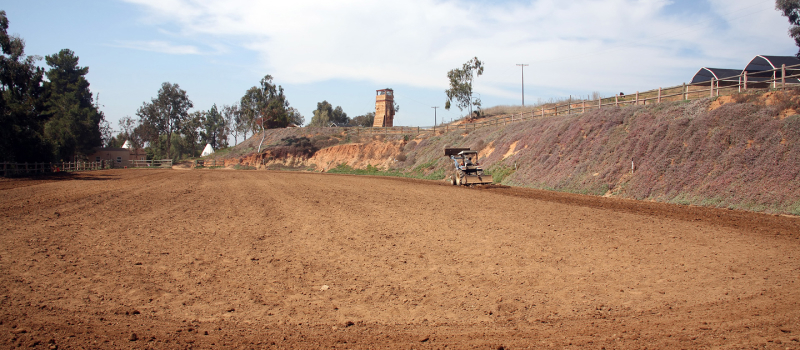
When planning your arena, determining the size should be your initial step. The dimensions will impact not only the budget but may also influence the location you select. Each equestrian discipline has unique space requirements for maneuvers and movements. Below is an overview of typical arena sizes for various disciplines:
Dressage Arena Dimensions:
- Small: 20 m x 20 m (65.6 ft x 65.6 ft) – Ideal for training sessions and smaller competitions.
- Standard: 20 m x 60 m (65.6 ft x 196.9 ft) – Commonly used for most competition levels, including international events.
- Large: 20 m x 80 m (65.6 ft x 262.5 ft) – Occasionally utilized for specialized training and events.
Size Specifications for Hunter/Jumper Arenas:
- Small: 20 m x 40 m (65.6 ft x 131.2 ft) – Suitable for warm-ups or training smaller horses.
- Standard: 50 m x 80 m (164 ft x 262.5 ft) – Typically used for various competitions, including the Olympics.
- Large: 60 m x 100 m (196.9 ft x 328.1 ft) – Ideal for large competitions and courses with extended galloping stretches.
Arena Dimensions for Other Riding Disciplines:
Barrel Racing
- Small: 100 ft x 100 ft – Used for training or smaller-scale events.
- Standard: 150 ft x 200 ft – The most common dimension for competitive barrel racing.
- Large: 180 ft x 250 ft – Suited for larger competitions and professional-level events.
Reining
- Standard: 100 ft x 200 ft – Common in competition and national events.
- Large: 150 ft x 300 ft – Used for international events and advanced reining activities.
Other Disciplines
- Polo: 300 ft x 600 ft – The standard field size for polo.
- Endurance Riding: Variable – Depending on race lengths and course designs, arenas can extend over miles.
#2: Cost Factors in Building a Horse Arena
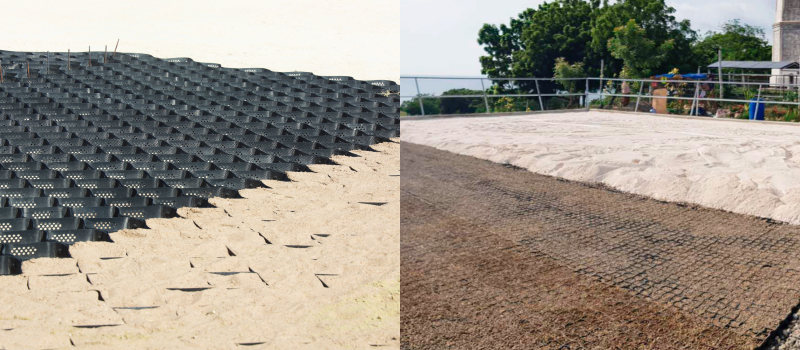
Building an outdoor horse arena involves various costs, with base construction being a significant expense. Traditional methods typically require substantial quantities of aggregate material, costing between $1.50 and $5 per square foot. However, BaseCore geocells offer potential savings and enhanced performance.
Performance Footing highlights that using BaseCore can reduce aggregate requirements by up to 50%, cutting material and labor costs. BaseCore’s interlocking design provides superior stability, minimizing compaction and reducing the need for frequent re-leveling, which in turn lowers long-term maintenance expenses.
Ideal for arenas on varied terrains, BaseCore and PaveCore ensures a consistent riding experience across different soil conditions. Its modular design allows for easy adjustments and repairs, benefiting arenas with heavy use or varying weather conditions. Adding Geotextile Fabric further enhances durability, acting as a barrier between soil layers, preventing contamination, and maintaining base integrity.
This combination supports your horses with a stable and safe surface, promoting cost-effectiveness and ease of maintenance. By investing in a high-quality base from the start, you avoid uneven footing and frequent repairs, ultimately saving time and money.
#3: Arena Drainage
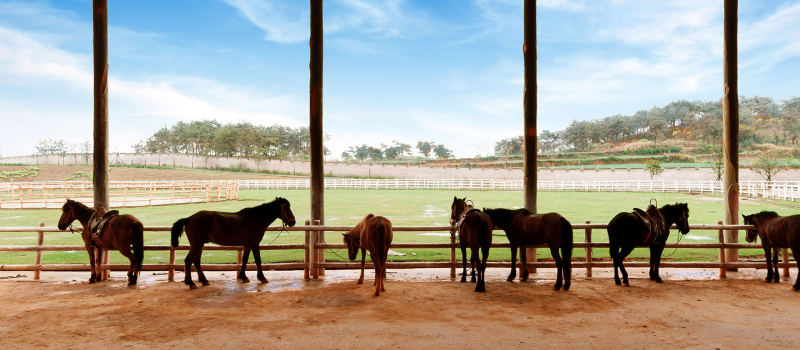
When it comes to arena drainage, understanding the principles that ensure efficient water management is paramount. 80% of arena issues are related to poor drainage. Your horse arena’s performance largely hinges on how well excess water is directed away from both the footing and the base layers. To minimize the risk of damage and ensure a safe, durable training environment, consider the following key principles:
- Grading and Slope: The first critical principle involves grading the arena properly. For outdoor setups, implementing a 1-2% crown in the center enables water to flow outward, preventing puddles and uneven footing.
- Perimeter Drains: Integrate a system of drains or runoffs around the arena’s perimeter to collect and direct water away efficiently. This can prevent water from seeping back into the arena, particularly during heavy rainfall.
- Retaining Boards: Install retaining boards around the arena edges to keep the footing contained and prevent it from migrating into the drainage system or surrounding areas. These boards help maintain the integrity of your arena’s drainage by ensuring that the materials stay in place.
- Base Material: Use a hard-packed material similar to what is used for road surfaces as your base. This layer should be compact and slightly permeable to facilitate water flow without becoming mushy or uneven.
- Indoor Arena Considerations: For indoor arenas, an integrated drainage system is crucial to handle any water that might seep through. Proper drainage solutions protect both the footing and the base from water damage.
Adhering to these principles not only preserves the arena’s footing quality but also extends its lifespan, ensuring a safe and enjoyable experience for both rider and horse.
#4: Essential Tools And Equipment For Arena Construction
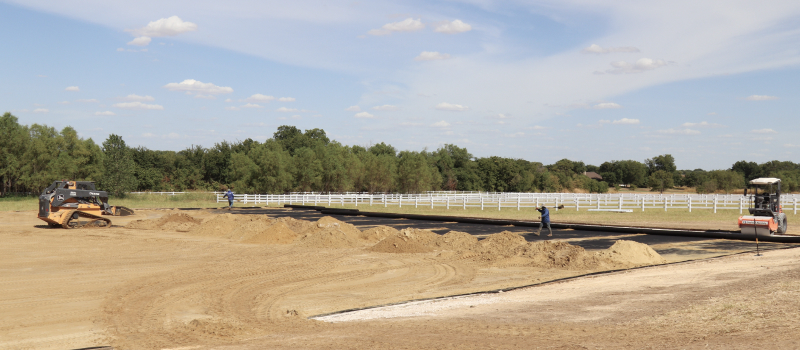
When embarking on the construction of your outdoor horse arena, equipping yourself with the right tools and machinery is crucial. Let’s break down what’s needed to transform your vision into reality.
- Excavator: Aids in site preparation and creating a level base.
- Laser Level: Ensures accurate measurements and a uniformly level base.
- Compactor: Presses and solidifies base layers to prevent shifting.
- Grip Rake: Distributes and levels the surface material.
- Gravel and Crushed Stone: Forms the base layer, aiding in drainage and providing a solid foundation.
- Top Footing Material: Choose the right footing, like sand or arena mix, for safety and performance.
After gathering tools and materials, follow a structured plan for smooth execution, and consider consulting experts. Investing in the right tools sets the foundation for a durable horse arena.
#5: Considering the Different Layers
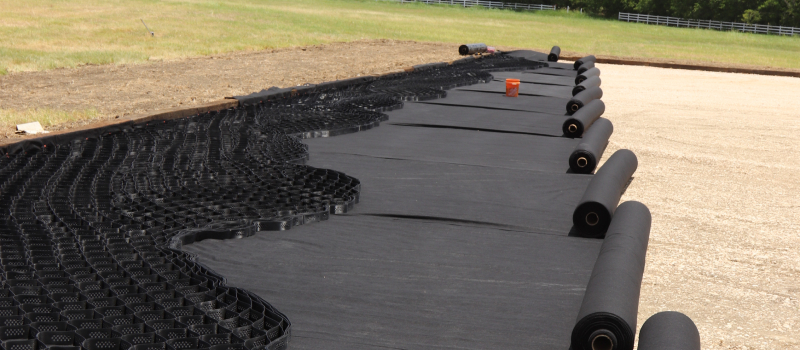
Building the perfect arena for your horses goes beyond aesthetics—it’s about crafting a safe, comfortable, and performance-boosting environment. Underneath the surface, there’s a carefully structured series of layers, each essential for achieving top-notch equestrian quality. Let’s dive into these vital components and explore modern alternatives for a cutting-edge arena:
1. Sub-Base: This is the foundation. Ensuring proper compaction and leveling of the native soil is critical. Research from the University of Kentucky highlights the importance of stable sub-bases to prevent uneven surfaces and potential injuries.
2. Aggregate Base: Essential for drainage and stability. A 4-6 inch layer of crushed rock is ideal for ensuring optimal water flow. Performance Footing’s studies support that angular crushed rock works best. Experiments by Texas A&M University also show that larger rock sizes can further improve drainage.
3. Geotextile Fabric: The silent guardian. This non-woven fabric acts as a barrier, stopping weed growth and soil migration. The National Institute of Building Sciences states how effective it is in maintaining long-term drainage efficiency.
4. BaseCore HD 3″ with Crusher Fines: A groundbreaking solution. These interlocking geocells provide exceptional stability while potentially reducing aggregate requirements by up to 50%, according to research by Performance Footing. This results in cost savings and a lighter structure that’s easier to compact.
5. Footing: Where performance meets the ground. This top layer (2-4 inches) offers exciting choices:
- Sand: An affordable and well-draining traditional option, though it does need frequent upkeep. Cornell University’s study underscores the need to maintain sand moisture for optimal performance.
- Arena Green: A modern non-water footing alternative. Research by Performance Footing shows its excellence in dust control, uniform footing, and reduced upkeep compared to sand.
- Sand/Footing Additive Mix: Customize your footing! By blending sand with Levitare, Foam Footing, or other additives, you can achieve the ideal balance of cushion and support. Studies by the Kentucky Equine Research Center reveal how different additives impact joint health and performance.
Remember, each layer plays a crucial role in your horses’ overall well-being. Consulting experienced arena builders ensures your material choices and construction techniques suit your soil, climate, and riding disciplines. By exploring innovative solutions like BaseCore, PaveCore and Arena Green, you can craft an arena that stands out and provides years of exceptional performance and equine satisfaction.
#6: Routine Maintenance Tips For Longevity
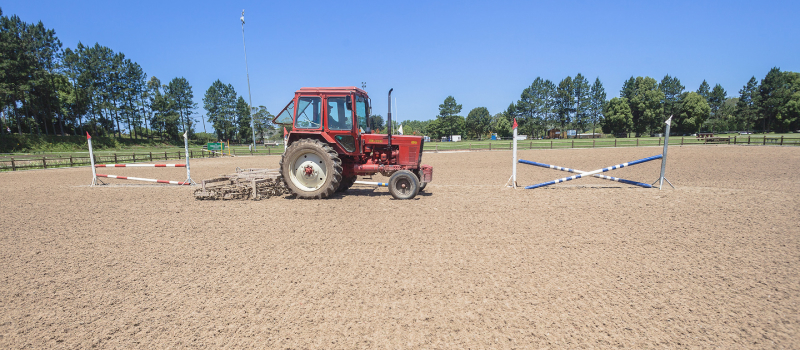
When it comes to ensuring the longevity and performance of your horse arena, establishing a solid base is paramount. This foundational layer directly impacts the lifespan and effectiveness of the arena footing. Think of it as the backbone of your facility, providing unwavering support for everything above it.
The Importance of Base Layer Construction
A meticulously constructed base layer facilitates proper drainage, mitigating the risk of water accumulation and subsequent damage. This ensures a consistent surface, free from hazardous, mushy spots that can compromise your horse’s performance and safety.
The Makeup of a Quality Base
Typically, a quality base layer involves multiple components. You’ll begin with a sub-base—an initial layer that helps distribute weight and manage water flow. Following this, a compacted aggregate base is laid. This layer consists of crushed stone or gravel, creating a firm yet permeable foundation that promotes drainage.
Ensuring Proper Compaction
The key to a durable base is achieving the right level of compaction. This process involves using heavy machinery to compress the materials, eliminating air gaps and enhancing stability. Proper compaction levels prevent the base from shifting over time, ensuring it maintains its structure even under constant use.
Benefits of Edge Boards
To further bolster the integrity of your base, consider the installation of edge boards around the perimeter of your arena. These boards secure the base material, preventing it from shifting due to environmental factors or daily use. They help maintain a consistent border, ensuring the base remains levelled and intact.
Periodic Base Assessment
Even with a well-constructed base, periodic assessment is crucial. Over time, natural settling and horse activity may necessitate adjustments. Regular inspections allow you to identify and address minor issues before they escalate, preserving the base’s effectiveness and extending the lifespan of your arena.
In conclusion, prioritizing the construction and maintenance of the base layer plays a critical role in the overall performance and durability of your horse arena. By investing in a strong foundation, you ensure that your footing materials can provide a safe, stable, and lasting surface for years to come.
How We Can Help You Build the Perfect Arena
Building the perfect arena for your horses can seem daunting, but don’t worry! Our team of footing experts is here to help. Whether you’re starting fresh or updating an existing arena, we’ll ensure a well-draining, stable foundation tailored to your needs.
Choosing the right footing is essential. Our experienced team will guide you through innovative options like FoamFooting, Levitare, and Noviun. We’ll help you find local suppliers and installers to integrate these cutting-edge materials seamlessly.
Think of us as your trusted guide, connecting you with local experts and helping you create a high-performance, dust-free arena where your horses can thrive. Let’s work together to build the arena of your dreams!
